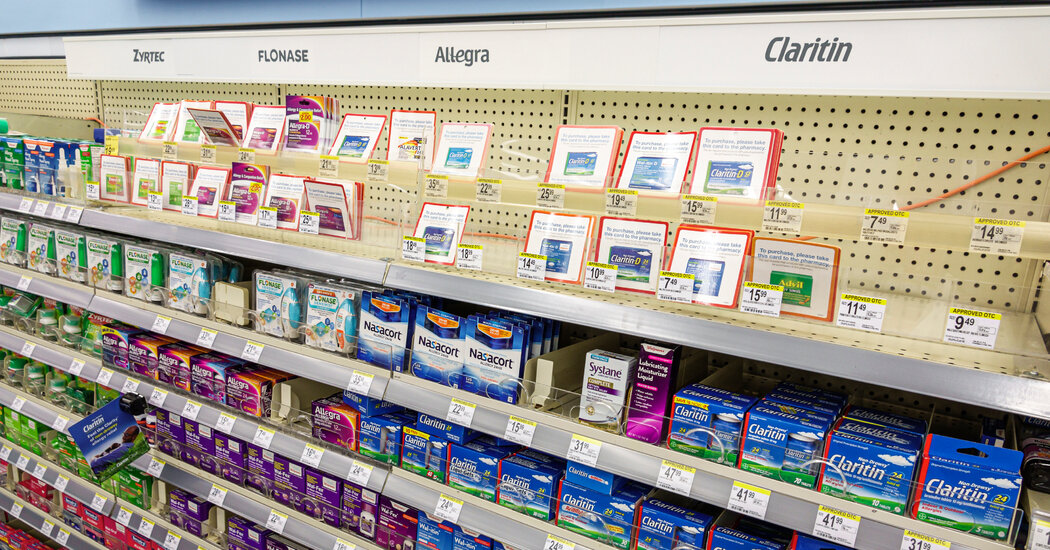With tree pollen counts already hitting peak levels in some parts of the United States, now is the time to start preparing for — and treating — your spring allergy symptoms.
But before you head to a pharmacy, consider some measures you can take at home. And if you do need to resort to medication, here’s what to know about the various pills, sprays and shots available.
Your first line of defense
Doctors recommend first trying to limit your exposure to whatever is triggering an allergic response — for example, tree pollen in the spring.
You can monitor local pollen levels on weather or allergy apps or on sites such as the National Allergy Bureau’s. When counts are high, doctors recommend keeping your windows closed, wearing a well-fitting mask outside and showering and changing your clothes when you get home. Pets can also bring in pollen from the outdoors, so keep them out of your bedroom and wash them regularly. When you come inside, you can also rinse out your nose with a saline spray or neti pot.
“It’s laborious, but the people who do this stuff find it really helpful,” said Dr. Neeta Ogden, a New-Jersey based allergist.
Nasal sprays
Dr. John Mafi, a primary care physician at UCLA Health who often treats patients with allergies, said that for those with moderate or severe seasonal allergies, the most effective treatment is typically a nasal corticosteroid spray.
These include fluticasone (Flonase), budesonide (Benacort), triamcinolone (Nasacort) and mometasone (Nasonex).
Allergens trigger inflammation in the nose, eyes, throat and, sometimes, the airway. “A local steroid is calming that area of inflammation,” Dr. Mafi said. Because nasal sprays are not absorbed systemically the way steroid pills are, they are considered low-risk, he added.
Spray with the nozzle pointed out toward the ears to get the greatest benefit and to avoid side effects like nose bleeds. The steroids can take several days to take effect, so doctors recommend using them from a week or two ahead of pollen season until pollen counts decline.
Antihistamines
Antihistamines reduce the itchiness and inflammation produced by histamine, a chemical your immune cells release when triggered by an allergen . They can be taken as pills, nasal sprays or eye drops. They work quickly and are most effective if taken as needed, such as on days when your symptoms are particularly bad.
“It can be like a rescue therapy,” said Dr. Farah Khan, an allergist and immunologist at Nationwide Children’s Hospital in Columbus, Ohio.
For itchy, watery eyes, antihistamine eye drops — often in conjunction with a nasal spray — tend to work best, Dr. Mafi said.
An oral antihistamine can be beneficial when you have multiple symptoms, like itchy eyes, a stuffy nose and hives, said Dr. Rita Kachru, chief of clinical allergy and immunology at UCLA Health.
In 2020, a task force of physicians that issues allergy treatment guidelines recommended against using “first-generation” oral antihistamines, such as diphenhydramine (Benadryl), for allergic rhinitis, especially on a chronic basis. The group cited negative side effects, including sedation, performance impairment and increased risk of dementia.
Doctors said the “second-generation” oral antihistamines loratadine (Claritin), cetirizine (Zyrtec) and fexofenadine (Allegra) won’t make most people drowsy, though patients are least likely to experience drowsiness with fexofenadine, Dr. Kachru said. These pills can cause side effects, including dry eyes or mouth and constipation.
If an antihistamine produces unpleasant side effects or stops working well, doctors suggest trying another one.
Decongestants
Some antihistamines, like Claritin-D and Allegra-D, come combined with pseudoephedrine (Sudafed). Doctors don’t recommend products that contain pseudoephedrine for children at all, or for adults for more than a few days in a row because the ingredient can increase heart rate and blood pressure.
Dr. Kachru also warned against using the decongestant nasal spray oxymetazoline (Afrin). Though it might provide relief, she said, over time you need more medication to get the same response. And stopping the medication can cause inflammation that can make it hard to breathe through your nose, she said.
Immunotherapy
Doctors recommend consulting a board-certified allergist if your symptoms are getting worse, interfering with daily life or causing other health problems, and medications aren’t helping. Dr. Ogden said patients often come to her when they can no longer tolerate taking medications for months on end.
“And then we have a talk about starting allergy shots,” she said.
Allergy shots deliver progressively higher doses of the protein you’re allergic to, teaching your immune system to tolerate it. The therapy, which has been approved by the Food and Drug Administration and is usually covered by insurance, has been shown to significantly reduce symptoms and medication use, and the effects can last for several years after treatment ends.
Another option is sublingual immunotherapy, in which you place a tablet containing the allergen under your tongue. The F.D.A. has approved tablets for ragweed, grasses and dust mites.
Both forms of immunotherapy require a substantial investment of time, usually three to five years. Scientists are studying other options. With climate change and air pollution making allergy symptoms worse, Dr. Ogden said, “I think immunotherapy is where we’re going to end up.”







